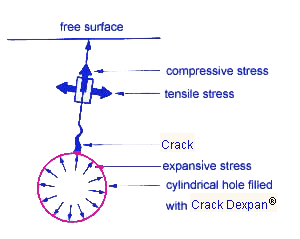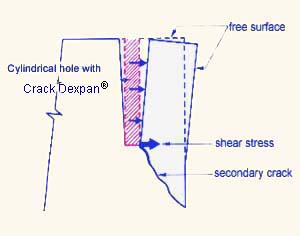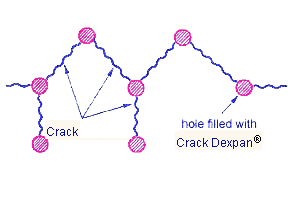Cracking Mechanism |
||
| Cracking
Mechanism |
After Crack Dexpan is poured into holes drilled in rocks or concrete, the expansive stress gradually increases with time, and reaches to more than 50Mpa equal to 6000 mt/m 2 at room temperature after 5 hours. As the Crack Dexpan generates its expansive stress, the material to be cracked undergoes a process of (1) crack initiation, (2) crack propagation, (3) the increase of crack width. Therefore, this fracture mechanism is distinguished from a breakage by blasting . The mechanism by the expansive stress of Crack Dexpan is shown in Fig. 1. Cracks initiate from an inner surface of the hole, being caused by tensile stress at a right angle with the compressive stress which occurs by the expansive stress of Crack Dexpan. The expansive stress of Crack Dexpan continues even after the appearance of cracks, the cracks propagate and also new cracks initiate during the process. Usually, for a single hole, 2-4 cracks initiate and propagate. When a free surface exists, the crack, as shown in Fig. 2, is pushed apart mainly by the shear stress, and a secondary crack also arises from the bottom of the hole running toward the free surface. Fig. 1 Fracture mechanism by the expansive stress of Crack Dexpan |
 |
| Fig. 2 Sectional-view of the crack formation in the material with two free surfaces |
 |
When multiple numbers of holes are filled with Crack Dexpan, that are properly adjacent to each other, the cracks from the hole propagate to connect with the neighboring holes, as shown in Fig. 3. It is therefore possible to determine the directions of the cracks as planned by appropriately arranging the hole spacing and its depth and its inclination. |

In the case of trenching, shafting or tunneling, if all holes are drilled vertically and filled with Crack Dexpan, the crack width can not increase but horizontal cracks initiate. Therefore, in order to obtain two free surfaces, inclined holes or pre-splitting must be required.